What is a general definition of 4 on 4 in basketball
4 on 4 is comprised of action that occurs when four players of one particular team compete on a basketball court against another four players from a different particular team, ultimately to win a game.
It should also be mentioned that in terms of an actual game, 4 on 4 is typically played as pickup basketball among friends or random people at an indoor gym or outdoor court.
What are the general rules for a 4 on 4 pickup basketball game
This is a basic explanation of the general rules for a 4 on 4 pickup basketball game, which usually features less formal structure than official basketball rules.
Nevertheless, it should be noted that these rules are not set in stone and could change to one degree or another based on player preferences.
Half court or full court
During a 4 on 4 pickup game, teams could choose to play on one half of the court sharing the same basket for scoring purposes, which is typically the case.
However, although not as common, the players could also opt to utilize a full court which would give both teams their own basket as well as access to a backcourt and a frontcourt.
Starting possession
The starting possession, or in other words, the team that gets to receive the ball first could be determined with something as simple as a coin flip.
Nonetheless, in most instances of 4 on 4 pickup, players on the two teams will usually shoot the ball a certain number of times from the free throw line or three-point line until one of the players from one particular team misses a shot.
Afterwards, the player from the team that missed the last shot would be the defensive team while the other team will have the starting possession on offense.
Points
Generally speaking, within pickup games, when an offensive player makes a field goal inside of the three-point line, this is usually worth one point as opposed to the standard two points within formal play.
Furthermore, when an offensive player makes a field goal outside of the three-point line, this is typically worth two points as opposed to the standard three-points within formal play.
Also, 4 on 4 pickup play, especially within the half court variation, typically does not implement a game clock that would normally determine the winner by the team that has the most points at the end of the timer.
Instead, within pickup games in general, the team that scores a certain amount of points first would be the winner of the game.
It should also be mentioned that 4 on 4 pickup, especially the half court variant, usually does not include a shot clock so it is not necessarily for teams to shoot the ball within a specified number of seconds.
In terms of the points that a team needs to score to win the 4 on 4 pickup game, this is commonly between 10 points and 15 points in most cases. However, that number could be lower or higher depending on the players’ preferences.
It should be noted as well that sometimes within pickup play, a blowout or skunk rule could be established by the players.
This generally means that if one particular team has a significant lead in points that is much higher than the opposing team, then that same opposing team would automatically lose the game.
For example, if Team A has 8 points and Team B has 0 points (i.e. Team B did not score any points), then this might qualify as an automatic loss for Team B.
In addition to that, players might decide to institute a win by two rule. This basically means that one team has to have a two-point lead over the opposing team upon reaching or exceeding the final score, which would also be determined prior to the game.
For example, let’s say that the players agree that a team has to score at least 15 points to win the game. Let’s also say that both teams have 14 points at a certain point during the game.
From there, with the win by two rule in place, if Team A scores one point to increase their total to 15, then that same team would not win the game.
Following that, if Team B does not score and remains at 14 but Team A is able to score one or two points to increase the lead to 16 points or 17 points respectively, then Team A would win that particular game.
Rebounds
The rules for rebounding in a 4 on 4 pickup game could slightly change depending on whether the game is played on a half court or full court.
If the 4 on 4 game gets played on a half court, then the rule for offensive rebounds would typically be very similar to the rules of rebounding for full court play.
That is to say, in the half court setting, when the player gets an offensive rebound, that same player can try to score immediately or if that is not feasible, then that same player could dribble the ball or pass it to a teammate.
Also, within a 4 on 4 half court pickup game, when a player gains a defensive rebound, the ball usually has to clear a certain perimeter area of the court, which is commonly the three-point line.
That is, when a player gains possession of the basketball via a defensive rebound, that same player will typically have to dribble it behind the three-point line or pass it to a teammate who is already behind the three-point line.
The reason that this rule for defensive rebounding is usually instituted is because it gives the opposing team enough time to protect the basket since both teams within a half court game do not have their own backcourt/frontcourt.
Put another way, without this rule, a player who is initially on defense could potentially grab the rebound and quickly score before the opposing team is able to react and defend the basket.
In most cases, this would probably be an unfair advantage, especially if that same player has a height or athletic advantage over the competition.
Additionally, it should be mentioned if a player does not clear after receiving the defensive rebound, then the other team could call for a non-clear rule break and receive possession of the ball.
Conversely, in a full court 4 on 4 game, when a player for a particular team collects a defensive rebound, this is the beginning of that same team’s transition offense.
Likewise, it is also the beginning of the opposing team’s transition defense. In other words, the team that was previously on defense has now transitioned into offense upon gaining possession of the basketball via the defensive rebound.
Similarly, the team that was previously on offense has currently transitioned into defense upon not gaining a secondary possession of the ball via an offensive rebound.
From that point, the new offensive team could dribble and/or pass the ball from their backcourt into their frontcourt, typically by way of fast break sequences such as primary break or secondary break as well as half court offensive series such as set plays, quick hitters or other strategies of basketball offense.
Simultaneously, the new defensive team has an opportunity to sprint into their backcourt, primarily to protect their basket and stop the new offensive team from scoring points.
Winner’s take or loser’s take
The winner’s take rule, which is sometimes referred to as “make it, take it” basically means that when an offensive team scores points, particularly within 4 on 4 half court pickup, that same team would receive the ball immediately afterwards.
Essentially, with the winner’s take rule, if the offensive team can score continuously either by not missing shots and/or by grabbing offensive rebounds, which could lead to second chance points, then the opposing defensive team may not ever receive the ball in a game.
On the other hand, the loser’s take rule, especially within the 4 on 4 half court pickup, is opposite of winner’s take. That is, when the offensive team scores, the opposing defensive team receives the ball thereafter.
In a basic sense, the loser’s take rule allows both teams an opportunity to gain offensive possession of the basketball.
In terms of implementing winner’s take or losers’ take, this is typically determined by the players on the court prior to the game.
It should also be mentioned that if teams decide to implement a full court 4 on 4 game, then the notion of winner’s or loser’s take would not be necessary as both teams would have an opportunity to receive the ball after the opposing team scores, particularly via the inbound pass.
Inbound pass
In the half court version of 4 on 4 pickup, following a made basket, one particular player, currently on offense, will commonly “take the ball out” on the opposite side of the midcourt line, which would also serve as the half court’s endline.
Afterwards, that same player can throw a inbound pass to a teammate and then play from there.
In the full court variation of 4 on 4 pickup, after a made basket, one specific player, currently on offense, will take the ball out behind the adjacent endline.
From there, that same player could throw the ball in to a teammate via the inbound pass.
Check
After a made basket or valid call, specifically within 4 on 4 half court pickup action, one particular player on defense can say “Check!” to briefly receive the ball from the offensive player that would throw the inbound pass prior to offensive execution.
From there, the defender could examine the ball and/or determine that teammates are in proper position and ready to play.
Out of Bounds
In 4 on 4 half court pickup, the primary boundary lines will include the two sidelines as well as the adjacent baseline and midcourt line.
Conversely, in 4 on 4 full court pickup, the main boundary lines would be the two sidelines plus the two baselines.
So, if a player on a team has possession of the ball and then that same player touches one of those boundary lines or passes over one of those lines, then this would be considered out of bounds.
Also, if any player was the last to touch the ball prior to it making contact with one of the boundary lines or the ball passes over one of those boundary lines, then that would be considered out of bounds as well.
From there, the opposing team would receive the ball and be able to execute the inbound pass, usually behind the midcourt line or opposite baseline based on the half court or full court variation, respectively
Additionally, in 4 on 4 full court pickup, if a team has possession of the ball in their frontcourt and the ball touches the midcourt line or passes over the midcourt line, particularly without it being last touched in the frontcourt by the opposing team, then this would generally be a backcourt violation.
Calls in relation to fouls or violations
Most of the time within pickup play such as 4 on 4 action, the players will make their own calls in relation to fouls or other violations.
In addition to that, when a potential dispute arises in reference to valid or invalid calls, one or more players from one team or both teams would typically shoot the ball from the free throw area or three-point line a certain number of times until someone misses a shot.
Following that, whichever player missed the last shot would lose the dispute and play could resume via the inbound pass.
What are examples of 4 on 4 basketball plays
These are examples of basic 4 on 4 basketball plays that could be utilized to create scoring opportunities near the basket or near the perimeter areas of the court.
It should be noted as well that for these particular plays, the numbers denoted as 1, 2, 3, and 4 generally represent a play initiator such as a point guard, a primary wing player such as a shooting guard, a secondary wing player such as a small forward, and a post player such as a power forward or center respectively.
However, this is primarily for demonstration purposes so it is possible for numbers and/or roles to change, depending on player preferences.
Example 1
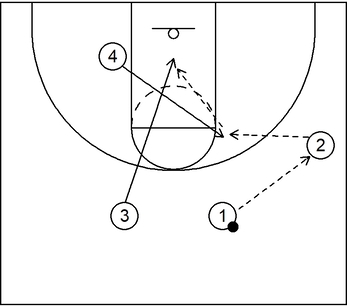
This is an example of a 4 on 4 play that is reminiscent of blind pig action within the triangle offense. To begin, 2 receives the ball from 1.
Next, 4 executes a flash cut to the right side high post from the left side low post area.
Following that, as soon as 4 has possession of the ball, 3 executes a backdoor cut to the basket. From there, 3 receives the ball from 4 and scores at the rim via a layup or dunk.
Example 2
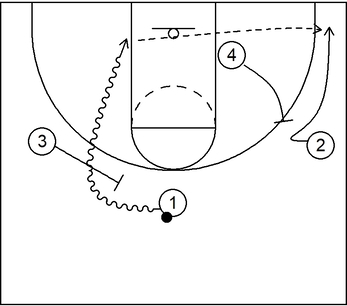
This is an example of a simple 4 on 4 play that seeks to create a scoring opportunity behind the three-point line. To start, 1 dribbles toward the basket on the left side by way of the on-ball screen set by 3.
As that action occurs, 2 cuts to the right side corner from the right side wing by way of the hammer screen set by 4.
Assuming the timing is correct, 2 receives the ball via the drift pass executed by 1. From there, 2 could take the three-point shot if that is open.
Example 3
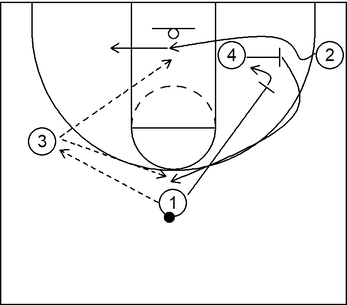
This is an example of a 4 on 4 basketball play that features elements of the flex offense. To begin, 3 receives the ball from 1. Next, 2 cuts to the basket from the right side corner via the flex screen set by 4.
After that, 2 could receive the ball from 3, assuming that is open. If it is not available, then 2 continues the cut towards the left side low post block.
Also, at the same time, 4 cuts to the top via the down screen set by 1. Following that, 4 could receive the ball from 3 and take the open jump shot.
Furthermore, 1 could move towards the right side low post block after the screening action to potentially gather an offensive rebound alongside 2.
Example 4 – Part 1
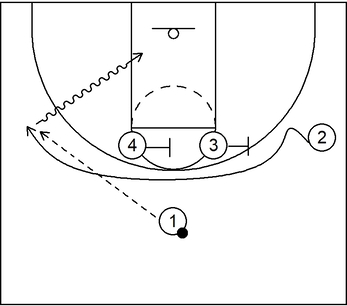
This is an example of a 4 on 4 play that features multiple scoring opportunities. To begin, 2 executes an Iverson cut across the court from the right side wing to the left side wing while additionally receiving high post screens from 3 and 4.
Next, 2 could receive the ball and take the open jump shot or attack the rim for a possible close-range shot.
Example 4 – Part 2
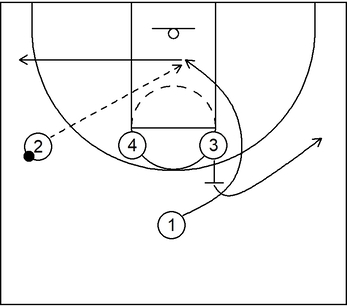
If 2 received the ball previously but did not take the jump shot or drive to the basket, then 1 could cut to the rim instead via the back screen set by 3.
Afterwards, 1 could receive the ball from 2 and score via the close-range shot. However, if 1 is not open, then 1 could continue the cut through to the left side corner.
Also, 3 could pop out to the right side wing following the screening action.
Example 4 – Part 3
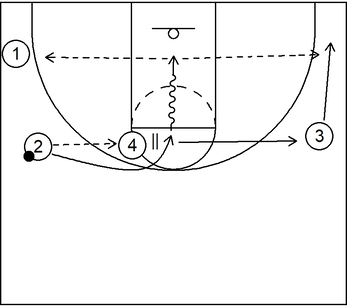
Next, 4 could receive the ball from 2 and then 2 could immediately follow that pass for a quick handoff from 4. After that, 2 could drive to the basket for a potential scoring opportunity.
Alternatively, 1 or 3 could receive the ball from 2 for possible jump shot opportunities as well.
However, if 2 is not open to receive the handoff, then 2 could simply cut through to the right side wing while 4 continues to hold the ball for the time being.
Example 4 – Part 4
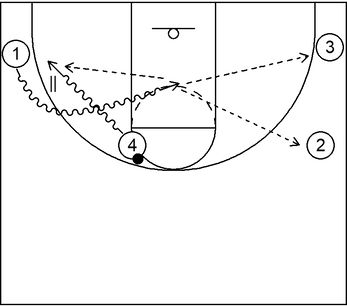
Once 2 fills the right side wing, 4 moves toward the left side corner to execute a dribble handoff with 1. From there, 1 receives the ball and attacks the rim for a possible scoring opportunity.
Also, 2, 3, or 4 could receive the ball from 1 for potential jump shot opportunities as well.